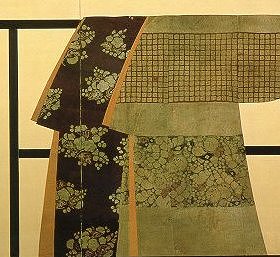
Kimono History: The Momoyama era
The Momoyama period (1573-1614) ushered in the basic design elements and techniques of decoration still seen on the modern kimono. Wealthy landowner and warriors rose to positions of power and gradually what was desired was anything new and novel (thus, fads have existed for a long, long time). Women still wore the kosode in public, but the wives of the various daimyos wore much fancier and elaborate clothing.

This is an example of work done during the late sixteenth to early seventeenth century. This is a kosode but the actual full design cannot be determined since only a fragment of the original kimono remains.
This was a long period of peace so this gave the textile industry a chance to evolve. The kosode became perfected during this time. The style spread to all classes of people and the dyeing and weaving was no longer exclusively for the upper classes. The actual design change was in going from a small, regular woven designs to designs dye by hand-painting.
One great artist from this time was Ogata Korin (1658-1716) who personally designed and decorated kimonos. Others include Maruyama Okyo (1726-1792) and Ando Hisoshige (1797-1858) who decorated kimonos with their own designs. That such famous artists were personally involved in the decorating of kimonos shows just how much importance was given to the artistic value of the kimono.
The Momoyama period (1573-1615CE) is considered one of the most brilliant and artistically productive times in Japanese history. The Nishijin district was established as the center of textile production. There were around 10,000 weavers working in Nishijin at that time.
European garments were imported during the 16th century and became, basically, the fashion rage among the upper classes.
During this time a new brocade known as kara-ori.
A process called tsujigahana was developed during this period. It combines stitched tie-dyeing and painting designs outlined in ink. Most of the garments using this process have survived only in fragments, though.
During this time the brighter colors were worn by men and the more delicate patterns and subdued colors were worn by women.
The kosode became the basic garment worn by both sexes. Kosode means "small sleeves", indicating that it has narrow sleeves whereas the kimono itself has wider sleeves. The exact definitions get murky, though. The furisode, for example, has long, swinging sleeves which should mean it is a kimono, but it is actually considered a kosode since the lower part of the sleeve was sewn together.
Another kimono type from this period is the jimbaori, worn by nobles. It was a sleeveless short coat worn by nobles over armor.
Main Index
Japan main page
Japanese-American Internment Camps index page
Japan and World War II index page
Back to start of kimono section
|